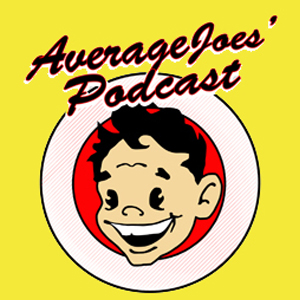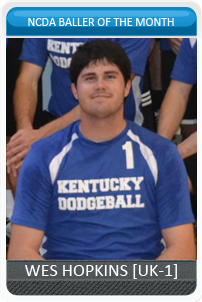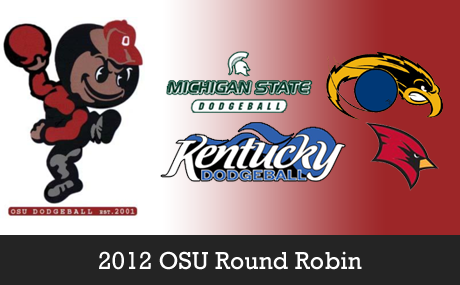 Hosts Mike Van Ermen and Sam Hiller go through the season’s opening games, and preview a few tournaments as well.
Hosts Mike Van Ermen and Sam Hiller go through the season’s opening games, and preview a few tournaments as well.
Recorded 10-19-2012
Podcast: Play in new window | Download
Subscribe: RSS
We are College Dodgeball
 Hosts Mike Van Ermen and Sam Hiller go through the season’s opening games, and preview a few tournaments as well.
Hosts Mike Van Ermen and Sam Hiller go through the season’s opening games, and preview a few tournaments as well.
Recorded 10-19-2012
Podcast: Play in new window | Download
Subscribe: RSS
COLLEGE PARK – Reckord Armory: Kent goes 4-0, JMU 3-0-1OTL, UK 2-1, UMD 2-2, VCU 0-4 in the UMD Round Robin Continue reading “UMD Round Robin”
EAST LANSING – IM West:
The fourth annual MSU Invite is the next big tournament on the NCDA docket after the Maryland Invite, and it should be a great one. Hosted by the Michigan State Spartans, they will be joined by Bowling Green, Central Michigan, DePaul, Kent State, and Moody Bible Institute. All six teams attending have played at least one match against a team in the tournament, but none of them have played matches against teams in their pool. The tournament is split into two separate three team pools, and everyone plays everyone in their pool. Then the first place team in each pool plays each other, the second place teams play each other, and the third place teams play each other.
BOWLING GREEN – Perry Fieldhouse: GVSU goes 3-0, CMU 2-1, SVSU 2-1, BGSU 1-2, Miami (OH) 0-3 in the BG Invitational. Continue reading “BG Invitational”
ALLENDALE: The GVSU Lakers enter the season as favorites again to win the National Championship, as they are nearly every season. Grand Valley begins play this weekend at the Bowling Green Invite, with matches against CMU, BGSU, and SVSU. With big rivalries at stake in their matches against Central Michigan and Saginaw Valley, the Lakers will look to get revenge over losing to CMU last season and losing to SVSU in the Michigan Dodgeball Cup and Nationals. Continue reading “Grand Valley Looking For Fifth Title”
University of Maryland Tournament Preview
COLLEGE PARK – Reckord Armory: This weekend features a great tournament at Bowling Green, but eyes will also be focused on the East Coast this Sunday as the University of Maryland hosts a variety of teams including Towson University (TU), Virginia Commonwealth University (VCU), James Madison University (JMU), last year’s regular season champion Kent State, and last year’s National finalist University of Kentucky (UK).
BOWLING GREEN – Perry Fieldhouse: BGSU will be hosting a tournament this weekend, featuring some of the biggest names in college dodgeball, as the Falcons will be joined by Central Michigan, Grand Valley, Saginaw Valley, and Miami. Continue reading “Bowling Green Round Robin Preview”
 The man with the howitzer arm, Wes Hopkins, is the Baller of the Month for the month of October. He got clocked in at over 80 mph at Nationals in April and was named to the All-NCDA team. His talent and growth as a player has helped turned Kentucky into a National title threat. He’s one of the most feared players in the league, and is one of the best players in Kentucky history. Continue reading “BOTM: 2012 October”
The man with the howitzer arm, Wes Hopkins, is the Baller of the Month for the month of October. He got clocked in at over 80 mph at Nationals in April and was named to the All-NCDA team. His talent and growth as a player has helped turned Kentucky into a National title threat. He’s one of the most feared players in the league, and is one of the best players in Kentucky history. Continue reading “BOTM: 2012 October”
COLUMBUS-RPAC: UK goes 3-0, MSU 3-1, Kent 2-2, SVSU 1-2-1OTL, OSU 0-4 in the OSU Round Robin. Continue reading “OSU Round Robin”
NCDA Newsletter
State of the Association
Ladies and Gentlemen,
The Season of 2011-2012 was fantastic for the National Collegiate Dodgeball Association. Continue reading “NCDA Newsletter: State of the Association”
The NCDA Rulebook has been updated for the season. Please check it out the PDF here or by clicking the handy link on the navigation menu above. If anyone finds anything wrong or contradictory to what’s been changed, please let it be known!
Thanks,
Zigmas Maloni – NCDA General Coordinator
Check out the revisions after the jump… Continue reading “2013 Rulebook Changes”

COLUMBUS: With the Buckeyes, Golden Flashes, Cardinals, Spartans, and Wildcats all heading to Columbus for a round robin, what is likely the second deepest tournament of the regular season (behind the Michigan Dodgeball Cup) could go to any of the attending teams. All five teams attending made the 2012 NCDA National Tournament Quarterfinals, three of them made the semifinals, and Kentucky and Saginaw Valley played for the title. The two teams that didn’t make the semifinals (Ohio State and Michigan State) both lost to teams in the OSU Round Robin by one point in the quarterfinals. There are also many rivalries in play here, whether its a Big Ten battle between MSU and OSU, or instate rivalries for Michigan and Ohio supremacy, or traditional dodgeball rivalries like SVSU/OSU or Kent State/Kentucky, nearly all the games will have some meaning. Teams are also getting to play other teams for the first time in a long time, like Kent State playing SVSU, and MSU playing Kentucky. Continue reading “Five Elite Programs Attending OSU Round Robin”
TOWSON: JMU goes 2-0, UMD 1-1, TU 0-2 in the Towson Throwdown
UMD def TU 6-0
JMU def UMD 5-2
JMU def TU 5-2
KENT: The Golden Flashes look to be preparing to break their own record for most matches played in a season, taking advantage of the NHL style points standings. Having already knocked off rival Ohio State 2-1, Kent State is currently tied for first in the standings, but a huge fall schedule should propel them to the top, even if they lose some games along the way. Continue reading “Kent State Loading Up Their Schedule”
KENT-Rec: Kent def OSU 2-1 in the Multi-purpose Room at the Rec Center
Kent State University and The Ohio State University met for their respective opening matches on Saturday September 15th at Kent State’s recreation center. Both teams were able to field a majority of veterans with Kent bringing two new players and Ohio State five. Ohio State got a quick win in the first match followed by back to back wins by Kent State. The last game came down to the wire, as Ohio State attempted to eliminate the few remaining Kent players left in play in order to gain a tie. The match ended with Kent State winning 2-1. There were approximately fifty fans in attendance.
– Dan Shackelford [Kent-33-C]